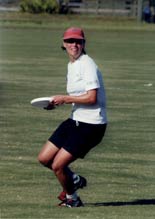Berkeleyan
Getting ultimate satisfaction
UC Extension staffer competes for world championship in obscure sport
![]()
| 26 August 2004
 Heidi Binder prepares for a measured toss of her Frisb — er, "flying disc." The ultimate player just returned from international competition in Finland. |
Many people refer to the game as “ultimate Frisbee,” though Binder says doing so is technically incorrect, since Frisbee is a trademarked name for what generically is called a “flying disc.” Binder recently had the apex of ultimate experiences: competing on the American women’s team in the World Ultimate and Guts Championships in Turku, Finland, during the first week of August.
Team USA came in third in a field of 13 teams. “We had quite a battle with the Japanese for the bronze,” says Binder. “There were a lot of very long points. Our team definitely put our hearts into winning that game.”
Each team’s culture was reflected in its playing style, she says: “The Japanese were very patient and accurate, whereas the Australians took more a live-fast/take-chances approach and made riskier choices on offense.”
Who are they to judge?
Played on a field measuring 70 yards by 40 yards that is bracketed by 25-yard end zones, ultimate involves two teams of seven players who attempt to maintain control of the disc in order to pass it into the other team’s end zone to score points, much like soccer. The non-contact sport is played without referees, so players do their own officiating, calling outside violations and fouls when necessary.
“What I love is that when the game is moving fast, you operate on pure reflex. It transcends thought,” Binder says. She was drawn to the sport originally after meeting ultimate players in college who struck her as “down-to-earth, very open people.” Binder knows a number of athletes who have transitioned from soccer, basketball, and track to ultimate. “I think people are attracted by the spirit of the game,” she says, “because the players all strive to maintain a sense of integrity over any foul call or the rules of the game.”
When Binder is not competing in global contests, she trains with and plays for a Bay Area team called Fury. “The game demands a high level of physical conditioning,” she says. “The first couple of times I played, I was sore for nearly three weeks afterward.”
Now Binder trains 15 to 20 hours during a typical week. In addition to Fury’s weekly games, and weekend scrimmages that focus on strategy, she takes part in one to two sessions involving repetitive uphill sprints, leg hops, and squat jumps. “Ultimate takes me to a level of fitness beyond what I ever thought I could achieve,” she says.
With the world championship behind her, Binder and her team are now preparing for competition closer to home. The sectionals, regionals, and nationals in ultimate play are slated for September and October.
For information about Fury, visit furyultimate.org.

